NPP-VIIRS Nighttime Lights Illustrate the Post-Earthquake Damage and Subsequent Economic Recovery in Hatay Province, Turkey
Abstract
:1. Introduction
2. Study Area and Data Sources
2.1. Study Area
2.2. Data Sources
3. Methodology
3.1. Methods of Assessing Earthquake Damage
- We extracted radiance, solar zenith angle, QF cloud mask, and moon illumination fraction from the VNP46A1 data for each pixel within the study area.
- To minimise the impact of solar illumination, pixels with a solar zenith angle of less than 108 degrees were excluded. On 12 February 2023, most pixels affected by clouds were concentrated over the Nur Mountains and the Mediterranean Sea, where their impact on urban illumination was minimal. Consequently, we could effectively eliminate these cloud-contaminated pixels using the QF cloud mask.
- To accurately identify cloud-contaminated pixels, we excluded all pixels with moon illumination levels exceeding 60% [36].
- The image was processed using two-dimensional linear interpolation techniques to fill in the vacant pixels left by the masking manipulation.
- Subsequently, the average value of the VNP46A1 image from the ocean, mountain, and desert regions was calculated to determine an NTL threshold. This threshold was used to eliminate background noise from the VNP46A1 image, as demonstrated in the following equation:
3.2. Method of Assessing Economic Recovery of Affected Regions
4. Results
4.1. Earthquake Damage Map from NTLs
4.2. Assessment of the Post-Earthquake Economic Recovery
5. Discussion
5.1. Relationships Between Reduced NTLs and Damaged Buildings
5.2. Reliability Analysis of NTL Data Reflecting the Level of Regional Economic Development
5.3. Validation of the Effectiveness of the Post-Earthquake Economic Recovery
5.3.1. Validation of the Effectiveness of the Post-Earthquake Economic Recovery Framework
5.3.2. Verification of Economic Recovery Across Various Districts Post-Earthquake
5.4. Strengths, Weaknesses, and Prospects of the Study
- The 500 m resolution of the data presents challenges in identifying earthquake damage within residential areas smaller than 0.25 km2. The mixed-pixel nature of the data generates composite signals that encompass various land covers, including structures with differing levels of damage. This blending diminishes the accuracy of assessing the specific damage status of individual structures. Moreover, illumination from interfering light sources—such as highway landscape lights, emergency rescue lights, and temporary warming fires—further compromises the accuracy of damage assessments. Notably, variations in NTL illumination exhibit a strong linear relationship (R2 > 0.7) with moderate to severe structural damage, yet only a weak linear correlation (R2 < 0.3) with slight structural damage. This disparity highlights the dual nature of NPP-VIIRS NTL data in seismic evaluations: while it excels in macro-level monitoring of significant building damage across large areas after major seismic events, its ability to detect minor damage—such as cracks or localised collapses—is limited by its low spatial resolution and the mixed-pixel effect, reducing its effectiveness in identifying low-intensity seismic damage scenarios.
- NTL data serve as a crucial proxy for gauging the intensity of human socioeconomic activities. However, its application in assessing economic recovery after an earthquake faces significant challenges due to its multidimensional complexity. Certain post-disaster economic behaviours can heavily interfere with NTL signals. For instance, the increased brightness from temporary settlement relief facilities and nighttime construction efforts can easily be misinterpreted as indications of short-term economic recovery. On the other hand, factors such as population migration and workforce loss can suppress NTL signals, reflecting a more profound decline in economic activity in the affected regions. Informal economic activities that emerge after disasters—such as unlit temporary markets and mobile vendors—are often excluded from NTL data analysis, potentially leading to a systemic underestimation of the resilience and recovery capacity of the post-disaster economy. Furthermore, data collected over the 22 months following the earthquake may primarily represent trends from the initial stages of economic recovery, thereby limiting the reliability of the findings.
6. Conclusions
Author Contributions
Funding
Data Availability Statement
Acknowledgments
Conflicts of Interest
Appendix A
Appendix A.1
| Point | Latitude | Longitude | City | Structure | Field Assessment | NTL Assessment |
|---|---|---|---|---|---|---|
| 33 | 36.229135 | 36.165190 | Antakya | Residential buildings | Severely damaged | Moderately damaged |
| 34 | 36.231058 | 36.165816 | Antakya | Residential buildings | Severely damaged | Moderately damaged |
| 35 | 36.230311 | 36.169230 | Antakya | Residential buildings | Severely damaged | Severely damaged |
| 36 | 36.229718 | 36.168989 | Antakya | Residential buildings | Severely damaged | Severely damaged |
| 37 | 36.229971 | 36.167919 | Antakya | Residential buildings | Severely damaged | Severely damaged |
| 38 | 36.229917 | 36.164761 | Antakya | Residential buildings | Severely damaged | Moderately damaged |
| 39 | 36.231030 | 36.166230 | Antakya | Residential buildings | Severely damaged | Moderately damaged |
| 40 | 36.227029 | 36.163210 | Antakya | Residential buildings | Severely damaged | No damage |
| 41 | 36.238769 | 36.175664 | Antakya | Residential buildings | Severely damaged | Severely damaged |
| 44 | 36.239264 | 36.175192 | Antakya | Residential buildings | Severely damaged | Severely damaged |
| 45 | 36.239587 | 36.174556 | Antakya | Residential buildings | Severely damaged | Severely damaged |
| 46 | 36.239842 | 36.174091 | Antakya | Residential buildings | Severely damaged | Severely damaged |
| 47 | 36.240405 | 36.173694 | Antakya | Residential buildings | Severely damaged | Severely damaged |
| 48 | 36.240463 | 36.173423 | Antakya | Residential buildings | Severely damaged | Severely damaged |
| 49 | 36.240688 | 36.173581 | Antakya | Residential buildings | Severely damaged | Severely damaged |
| 50 | 36.240839 | 36.173702 | Antakya | Residential buildings | Severely damaged | Severely damaged |
| 51 | 36.239997 | 36.173350 | Antakya | Residential buildings | Severely damaged | Severely damaged |
| 52 | 36.240112 | 36.173131 | Antakya | Residential buildings | Severely damaged | Severely damaged |
| 53 | 36.240274 | 36.173241 | Antakya | Residential buildings | Severely damaged | Severely damaged |
| 54 | 36.240429 | 36.172994 | Antakya | Residential buildings | Severely damaged | Severely damaged |
| 55 | 36.240267 | 36.172886 | Antakya | Residential buildings | Severely damaged | Severely damaged |
| 56 | 36.240550 | 36.172784 | Antakya | Residential buildings | Severely damaged | Severely damaged |
| 57 | 36.240416 | 36.172655 | Antakya | Residential buildings | Severely damaged | Severely damaged |
| 58 | 36.240745 | 36.172505 | Antakya | Residential buildings | Severely damaged | Severely damaged |
| 59 | 36.241039 | 36.172805 | Antakya | Residential buildings | Severely damaged | Severely damaged |
| 60 | 36.241110 | 36.172623 | Antakya | Residential buildings | Severely damaged | Severely damaged |
| 61 | 36.240215 | 36.172083 | Antakya | Residential buildings | Severely damaged | Severely damaged |
| 62 | 36.240042 | 36.172413 | Antakya | Residential buildings | Severely damaged | Severely damaged |
| 63 | 36.239851 | 36.172581 | Antakya | Residential buildings | Severely damaged | Severely damaged |
| 64 | 36.239735 | 36.172734 | Antakya | Residential buildings | Severely damaged | Severely damaged |
| 65 | 36.241418 | 36.172778 | Antakya | Residential buildings | Severely damaged | Severely damaged |
| 66 | 36.241354 | 36.172972 | Antakya | Residential buildings | Severely damaged | Severely damaged |
| 83 | 36.241648 | 36.173339 | Antakya | Residential buildings | Severely damaged | Severely damaged |
| 77 | 36.582782 | 36.169085 | Iskenderun | Residential buildings | Severely damaged | Severely damaged |
| 78 | 36.206695 | 36.152426 | Antakya | Residential buildings | Severely damaged | Severely damaged |
| 79 | 36.230528 | 36.150281 | Antakya | Residential buildings | Severely damaged | Slightly damaged |
| 80 | 36.241316 | 36.174080 | Antakya | Residential buildings | Severely damaged | Severely damaged |
| 81 | 36.241375 | 36.174252 | Antakya | Residential buildings | Severely damaged | Severely damaged |
| 82 | 36.240990 | 36.173876 | Antakya | Residential buildings | Severely damaged | Severely damaged |
| 67 | 36.241648 | 36.173339 | Antakya | Residential buildings | Severely damaged | Severely damaged |
| 84 | 36.241127 | 36.175161 | Antakya | Residential buildings | Severely damaged | Severely damaged |
| 85 | 36.239203 | 36.174925 | Antakya | Residential buildings | Severely damaged | Severely damaged |
| 86 | 36.239916 | 36.177123 | Antakya | Residential buildings | Severely damaged | Severely damaged |
| 111 | 36.185111 | 36.121000 | Antakya | School buildings | Severely damaged | Severely damaged |
| 0 | 36.569031 | 36.166170 | Iskenderun | Medical buildings | Severely damaged | Severely damaged |
| 116 | 36.270309 | 36.223331 | Antakya | Medical buildings | Slightly damaged | Slightly damaged |
| 124 | 36.240469 | 36.174834 | Antakya | Critical buildings | Severely damaged | Severely damaged |
| 130 | 36.591100 | 36.168200 | Iskenderun | Religious buildings | Severely damaged | Severely damaged |
| 148 | 36.361587 | 36.286585 | Antakya | Airports | Severely damaged | Severely damaged |
| 150 | 36.231208 | 36.166476 | Antakya | Roads and bridges | Severely damaged | Moderately damaged |
| 26 | 36.195933 | 36.158567 | Antakya | Residential buildings | Severely damaged | Severely damaged |
| 87 | 36.589400 | 36.178200 | Iskenderun | Residential buildings | Severely damaged | Moderately damaged |
| 104 | 36.245400 | 36.569900 | Reyhanli | Residential buildings | Severely damaged | Moderately damaged |
| 119 | 36.235400 | 36.169500 | Antakya | Medical buildings | Severely damaged | Severely damaged |
| 126 | 36.201500 | 36.165500 | Antakya | Religious buildings | Severely damaged | Severely damaged |
| 133 | 36.201500 | 36.165500 | Antakya | Historic buildings | Severely damaged | Severely damaged |
| 135 | 36.531637 | 36.364843 | Kirikhan | Historic buildings | Severely damaged | No damage |
| 136 | 36.201900 | 36.162100 | Antakya | Historic buildings | Severely damaged | Severely damaged |
| 158 | 36.200000 | 36.159000 | Antakya | Roads and bridges | Slightly damaged | Severely damaged |
References
- The M7.8 and M7.5 Kahramanmaraş Earthquake Sequence Struck Near Nurdagi, Turkey on 6 February 2023. Available online: https://www.usgs.gov/news/featured-story/m78-and-m75-kahramanmaras-earthquake-sequence-near-nurdagi-turkey-turkiye (accessed on 3 July 2024).
- Taftsoglou, M.; Valkaniotis, S.; Papathanassiou, G.; Karantanellis, E. Satellite Imagery for Rapid Detection of Liquefaction Surface Manifestations: The Case Study of Turkey–Syria 2023 Earthquakes. Remote Sens. 2023, 15, 4190. [Google Scholar]
- Ezgi Guvercin, S. 2023 Earthquake Doublet in Turkey Reveals the Complexities of the East Anatolian Fault Zone: Insights from Aftershock Patterns and Moment Tensor Solutions. Seismol. Res. Lett. 2024, 95, 664–679. [Google Scholar] [CrossRef]
- One Year After Turkey’s Earthquakes, Recovery Takes Many Forms. Available online: https://www.undp.org/eurasia/stories/one-year-after-turkiyes-earthquakes-recovery-takes-many-forms (accessed on 3 July 2024).
- Gu, J.; Xie, Z.; Zhang, J.; He, X. Advances in Rapid Damage Identification Methods for Post-Disaster Regional Buildings Based on Remote Sensing Images: A Survey. Buildings 2024, 14, 898. [Google Scholar] [CrossRef]
- Zheng, Q.; Seto, K.C.; Zhou, Y.; You, S.; Weng, Q. Nighttime Light Remote Sensing for Urban Applications: Progress, Challenges, and Prospects. ISPRS J. Photogramm. 2023, 202, 125–141. [Google Scholar] [CrossRef]
- Liu, C.; Tang, Q.; Xu, Y.; Wang, C.; Wang, S.; Wang, H.; Li, W.; Cui, H.; Zhang, Q.; Li, Q. High-Spatial-Resolution Nighttime Light Dataset Acquisition Based on Volunteered Passenger Aircraft Remote Sensing. IEEE Trans. Geosci. Remote Sens. 2022, 60, 1001817. [Google Scholar]
- Li, F.; Liu, X.; Liao, S.; Jia, P. The Modified Normalized Urban Area Composite Index: A Satelliate-Derived High-Resolution Index for Extracting Urban Areas. Remote Sens. 2021, 13, 2350. [Google Scholar] [CrossRef]
- Zhang, H.; Yu, Q.; Liu, Y.; Jiang, J.; Chen, J.; Liu, R. The Spatio-Temporal Patterns of Regional Development in Shandong Province of China from 2012 to 2021 Based on Nighttime Light Remote Sensing. Sensors 2023, 23, 8728. [Google Scholar] [CrossRef]
- Chen, L.; Yu, L.; Yin, J.; Xi, M. Impact of Population Density on Spatial Differences in the Economic Growth of Urban Agglomerations: The Case of Guanzhong Plain Urban Agglomeration, China. Sustainability 2023, 15, 14601. [Google Scholar] [CrossRef]
- Li, L.-L.; Liang, P.; Jiang, S.; Chen, Z.-Q. Multi-Scale Dynamic Analysis of the Russian–Ukrainian Conflict from the Perspective of Night-Time Lights. Appl. Sci. 2022, 12, 12998. [Google Scholar] [CrossRef]
- Wang, L.; Li, Z.; Han, J.; Fan, K.; Chen, Y.; Wang, J.; Fu, J. A Cost-Effective Earthquake Disaster Assessment Model for Power Systems Based on Nighttime Light Information. Appl. Sci. 2024, 14, 2325. [Google Scholar] [CrossRef]
- Sarkar, S. Rapid Assessment of Cyclone Damage Using NPP-VIIRS DNB and Ancillary Data. Nat. Hazards 2021, 106, 579–593. [Google Scholar] [CrossRef] [PubMed]
- Levin, N. Using Night Lights from Space to Assess Areas Impacted by the 2023 Turkey Earthquake. Remote Sens. 2023, 15, 2120. [Google Scholar] [CrossRef]
- Yuan, Y.; Wang, C.; Liu, S.; Chen, Z.; Ma, X.; Li, W.; Zhang, L.; Yu, B. The Changes in Nighttime Lights Caused by the Turkey–Syria Earthquake Using NOAA-20 VIIRS Day/Night Band Data. Remote Sens. 2023, 15, 3438. [Google Scholar] [CrossRef]
- Fan, X.; Nie, G.; Deng, Y.; An, J.; Zhou, J.; Li, H. Rapid Detection of Earthquake Damage Areas Using VIIRS Nearly Constant Contrast Night-Time Light Data. Int. J. Remote Sens. 2018, 40, 2386–2409. [Google Scholar] [CrossRef]
- Xiao, Z.; Pan, Y.; Jiang, L.; Wang, Z.; Shi, K. Remote Sensing Nighttime Lights Reveal the Post-Earthquake Losses and Reconstruction Situations in Turkey–Syria Earthquake Areas. IEEE Geosci. Remote Sens. Lett. 2024, 21, 3002405. [Google Scholar] [CrossRef]
- Li, X.; Liu, Z.; Chen, X.; Meng, Q. Assessment of the Impact of the 2010 Haiti Earthquake on Human Activity Based on DMSP/OLS Time Series Nighttime Light Data. J. Appl. Remote Sens. 2019, 13, 044515. [Google Scholar] [CrossRef]
- Wang, J.; Zhang, J.; Gong, L.; Li, Q.; Zhou, D. Indirect Seismic Economic Loss Assessment and Recovery Evaluation Using Nighttime Light Images—Application for Wenchuan Earthquake. Nat. Hazards Earth Syst. Sci. 2018, 18, 3253–3266. [Google Scholar] [CrossRef]
- Jia, M.; Li, X.; Gong, Y.; Belabbes, S.; Dell’Oro, L. Estimating Natural Disaster Loss Using Improved Daily Night-Time Light Data. Int. J. Appl. Earth Obs. Geoinf. 2023, 120, 103359. [Google Scholar] [CrossRef]
- Li, F.; Wang, Q.; Hu, W.; Liu, J.; Zhang, X. Rapid Assessment of Disaster Damage and Economic Resilience in Relation to the Flooding in Zhengzhou, China in 2021. Remote Sens. Lett. 2022, 13, 651–662. [Google Scholar] [CrossRef]
- Gao, S.; Chen, Y.; Liang, L.; Gong, A. Post-Earthquake Night-Time Light Piecewise (PNLP) Pattern Based on NPP/VIIRS Night-Time Light Data: A Case Study of the 2015 Nepal Earthquake. Remote Sens. 2020, 12, 2009. [Google Scholar] [CrossRef]
- Liu, Z.; Zhang, J.; Li, X.; Chen, X. Long-Term Resilience Curve Analysis of Wenchuan Earthquake-Affected Counties Using DMSP-OLS Nighttime Light Images. IEEE J. Sel. Top. Appl. Earth Obs. Remote Sens. 2021, 14, 10854–10874. [Google Scholar] [CrossRef]
- Chen, X.; Li, X.; Liu, Z. Evaluation of Earthquake Disaster Recovery Patterns and Influencing Factors: A Case Study of the 2008 Wenchuan Earthquake. All Earth 2023, 35, 132–148. [Google Scholar]
- Hatay Province. Available online: https://en.wikipedia.org/wiki/Hatay_Province#Geography (accessed on 20 May 2024).
- 2023 Turkey–Syria Earthquakes. Available online: https://en.wikipedia.org/wiki/2023_Turkey%E2%80%93Syria_earthquakes#cite_note-TRToll9FEB-104 (accessed on 3 July 2024).
- Global Rapid Post-Disaster Damage Estimation (GRADE) Report. Available online: https://documents1.worldbank.org/curated/en/099022723021250141/pdf/P1788430aeb62f08009b2302bd4074030fb.pdf (accessed on 3 July 2024).
- Alahmadi, M.; Mansour, S.; Dasgupta, N.; Abulibdeh, A.; Atkinson, P.M.; Martin, D.J. Using Daily Nighttime Lights to Monitor Spatiotemporal Patterns of Human Lifestyle under COVID-19: The Case of Saudi Arabia. Remote Sens. 2021, 13, 4633. [Google Scholar] [CrossRef]
- Level-1 and Atmosphere Archive & Distribution System Distributed Active Archive Center. Available online: https://ladsweb.modaps.eosdis.nasa.gov/search/ (accessed on 3 July 2024).
- EarthExplorer. Available online: https://earthexplorer.usgs.gov/ (accessed on 3 January 2025).
- M7.8 2023 Turkey EQ Building Damage (Last Updated 9 March 2023). Available online: https://www.arcgis.com/home/item.html?id=86941dbff14e450bbe3f89897373c59a (accessed on 3 July 2024).
- Turkey Damage Assessment. Available online: https://ollielballinger.users.earthengine.app/view/turkey-earthquake (accessed on 15 March 2025).
- StEER-6 February 2023, Kahramanmaras, Turkey, Mw 7.8 Earthquake. Available online: https://www.designsafe-ci.org/data/browser/public/designsafe.storage.published/PRJ-3824 (accessed on 3 January 2025).
- Data Portal for Statistics. Available online: https://data.tuik.gov.tr/Search/Search?text=gdp%20by%20province&dil=2 (accessed on 3 January 2025).
- Download GADM Data (Version 4.1). Available online: https://gadm.org/download_country.html (accessed on 4 June 2024).
- Zheng, Z.; Wu, Z.; Chen, Y.; Guo, G.; Yang, Z.; Marinello, F. A Simple Method for Near-Real-Time Monthly Nighttime Light Image Production. IEEE Geosci. Remote Sens. Lett. 2022, 19, 8008405. [Google Scholar]
- Zhang, D.; Huang, H.; Roy, N.; Roozbahani, M.M.; Frost, J.D. Black Marble Nighttime Light Data for Disaster Damage Assessment. Remote Sens. 2023, 15, 4257. [Google Scholar] [CrossRef]
- Duerler, R.; Cao, C.; Xie, B.; Huang, Z.; Chen, Y.; Wang, K.; Xu, M.; Lu, Y. Cross Reference of GDP Decrease with Nighttime Light Data via Remote Sensing Diagnosis. Sustainability 2023, 15, 6900. [Google Scholar] [CrossRef]
- Liu, H.; Luo, N.; Hu, C. Detection of County Economic Development Using LJ1-01 Nighttime Light Imagery: A Comparison with NPP-VIIRS Data. Sensors 2020, 20, 6633. [Google Scholar] [CrossRef]
- Li, F.; Liu, J.; Zhang, M.; Liao, S.; Hu, W. Assessment of Economic Recovery in Hebei Province, China, Under the COVID-19 Pandemic Using Nighttime Light Data. Remote Sens. 2023, 15, 22. [Google Scholar] [CrossRef]
- Zheng, Y.; Shao, G.; Tang, L.; He, Y.; Wang, X.; Wang, Y.; Wang, H. Rapid Assessment of a Typhoon Disaster Based on NPP-VIIRS DNB Daily Data: The Case of an Urban Agglomeration Along Western Taiwan Straits, China. Remote Sens. 2019, 11, 1709. [Google Scholar] [CrossRef]
- Zheng, X.; Li, L. Trading Cloud Computing Stocks Using SMA. Information 2024, 15, 506. [Google Scholar] [CrossRef]
- Choi, S.; An, J. Multisensor Feature Selection for Maritime Target Estimation. Electronics 2024, 13, 4497. [Google Scholar] [CrossRef]
- Herianto, H.; Sofroniou, A.; Fitrah, M.; Rosana, D.; Setiawan, C.; Rosnawati, R.; Widihastuti, W.; Jusmiana, A.; Marinding, Y. Quantifying the Relationship Between Self-Efficacy and Mathematical Creativity: A Meta-Analysis. Educ. Sci. 2024, 14, 1251. [Google Scholar] [CrossRef]
- Li, F.; Liao, S.; Liu, W. Assessment of Post-Pandemic Economic Recovery in Beijing, China, Using Night-Time Light Data. Remote Sen. Lett. 2024, 15, 603–613. [Google Scholar] [CrossRef]
- Qiang, Y.; Huang, Q.; Xu, J. Observing Community Resilience from Space: Using Nighttime Lights to Model Economic Disturbance and Recovery Pattern in Natural Disaster. Sustain. Cities Soc. 2020, 57, 102115. [Google Scholar] [CrossRef]
- Turkey Earthquake: Why Reconstruction Could Miss Erdogan’s Goal. Available online: https://www.reuters.com/world/middle-east/turkey-earthquake-why-reconstruction-could-miss-erdogans-goal-2023-10-13 (accessed on 24 January 2025).
- Current Projects and Investments. Available online: https://hatayplanlamamerkezi.com/tr-TR/projects/proje-yatirim (accessed on 18 March 2025).
- 2 Years on, New City Emerges from Turkey’s Quake-Hit Ruins. Available online: https://www.dailysabah.com/turkiye/2-years-on-new-city-emerges-from-turkiyes-quake-hit-ruins/news (accessed on 18 March 2025).
- Hatay After Earthquakes: Changing Priorities and Problems. Available online: https://bianet.org/haber/hatay-after-earthquakes-changing-priorities-and-problems-304510 (accessed on 18 March 2025).
- Monitoring Report on the First Year in Hatay Province. Available online: https://drive.google.com/file/d/1ddD-KfLqaTmSjZrokHou7Nf_l_xUKKU-/view?usp=sharing (accessed on 18 March 2025).
- Turkey’s Iskenderun Port to Restart in Three Months. Available online: https://mykn.kuehne-nagel.com/news/article/trkiyes-iskenderun-port-to-restart-in-three-m-21-Feb-2023 (accessed on 19 March 2025).
- Post-Earthquake Small Business Recovery in Hatay, Turkey. Available online: https://www.livelihoodscentre.org/-/post-earthquake-small-business-recovery-in-hatay-turkey#:~:text=The%20economic%20cost%20of%20the%20earthquake%20was,effects%20on%20the%20labor%20market%20and%20businesses.&text=This%20learning%20brief%20focuses%20on%20lessons%20of,includes%20recommendations%20for%20scaling%20in%20this%20context (accessed on 19 March 2025).
- CORE Worked with Our Local Partners to Provide Emergency Relief and Recovery to Communities Impacted by Devastating Earthquakes that Struck Southern Turkey. Available online: https://www.coreresponse.org/turkey-syria-earthquake/#:~:text=In%20the%20Hassa%20district%20of,affecting%20more%20than%20350%20people (accessed on 19 March 2025).
- 2023 Kahramanmaraş, Turkey Earthquake Sequence: Observations of Recovery 20 Months After. Available online: https://learningfromearthquakes.org/resources/eeri-sseer-resilience-reconnaissance-team-report-2023-kahramanmaras-turkiye-earthquake-sequence/ (accessed on 19 March 2025).
- Turkey Earthquakes Operation Update #7—Emergency Appeal No. MDRTR004. Available online: https://reliefweb.int/report/turkiye/turkiye-earthquakes-operation-update-7-emergency-appeal-no-mdrtr004-06122024 (accessed on 19 March 2025).
- 2 Years on, Quake-Hit Turkish Provinces Regain Economic Pace. Available online: https://www.dailysabah.com/business/economy/2-years-on-quake-hit-turkish-provinces-regain-economic-pace (accessed on 19 March 2025).
- Tziokas, N.; Zhang, C.; Drolias, G.C.; Atkinson, P.M. Downscaling Satellite Night-Time Lights Imagery to Support Within-City Applications Using a Spatially Non-Stationary Model. Int. J. Appl. Earth Obs. Geoinf. 2023, 122, 103395. [Google Scholar] [CrossRef]

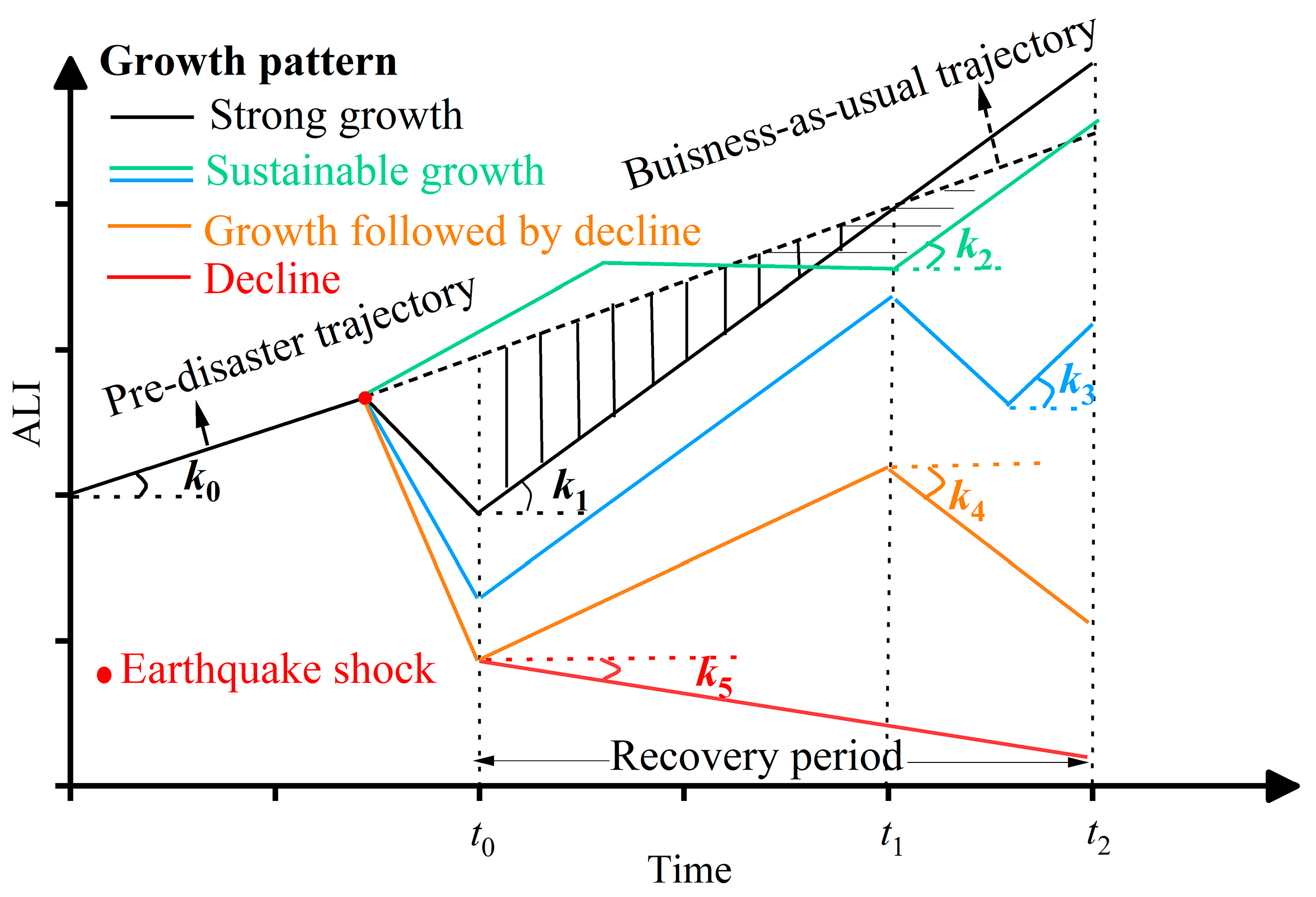
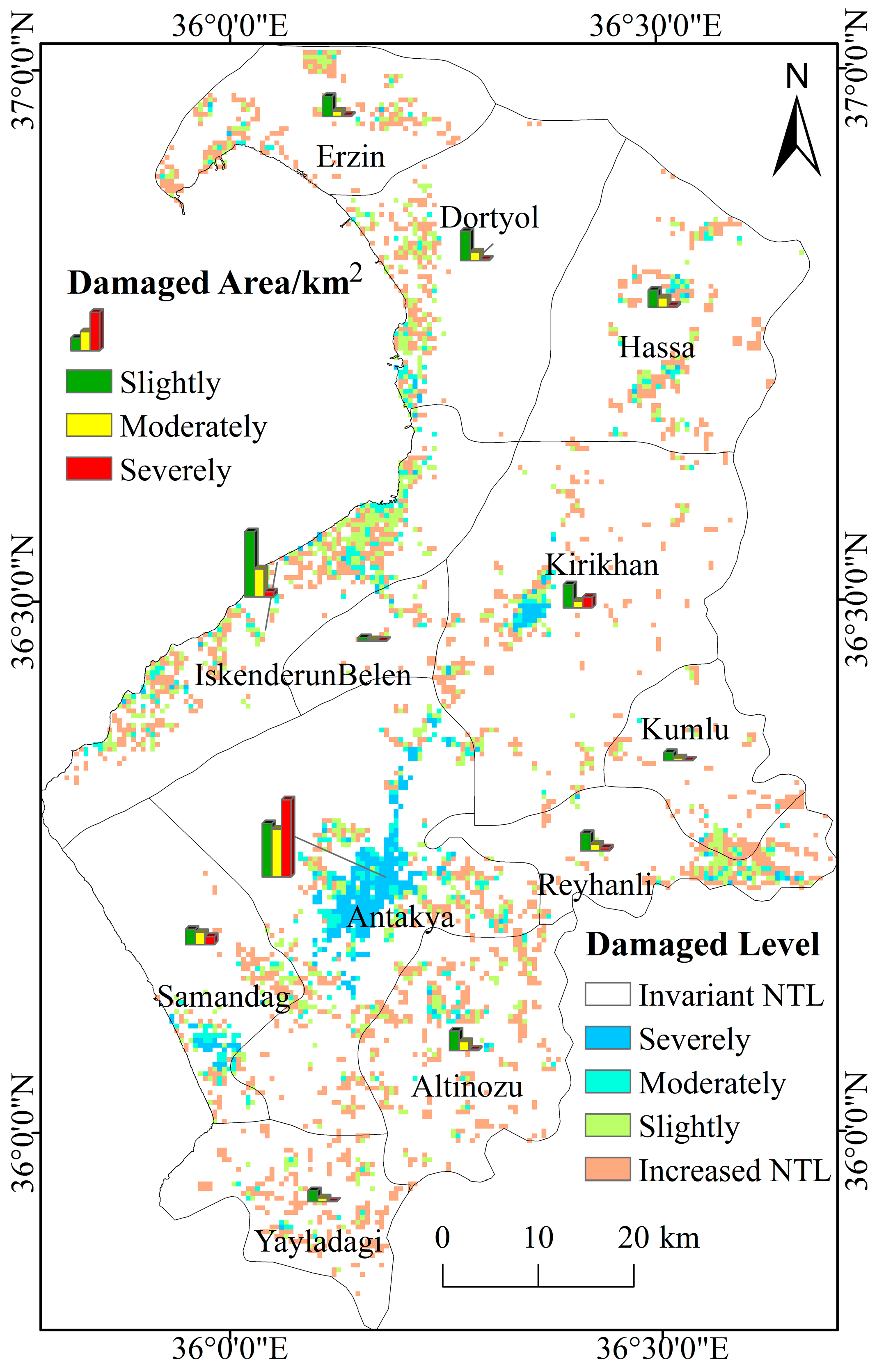
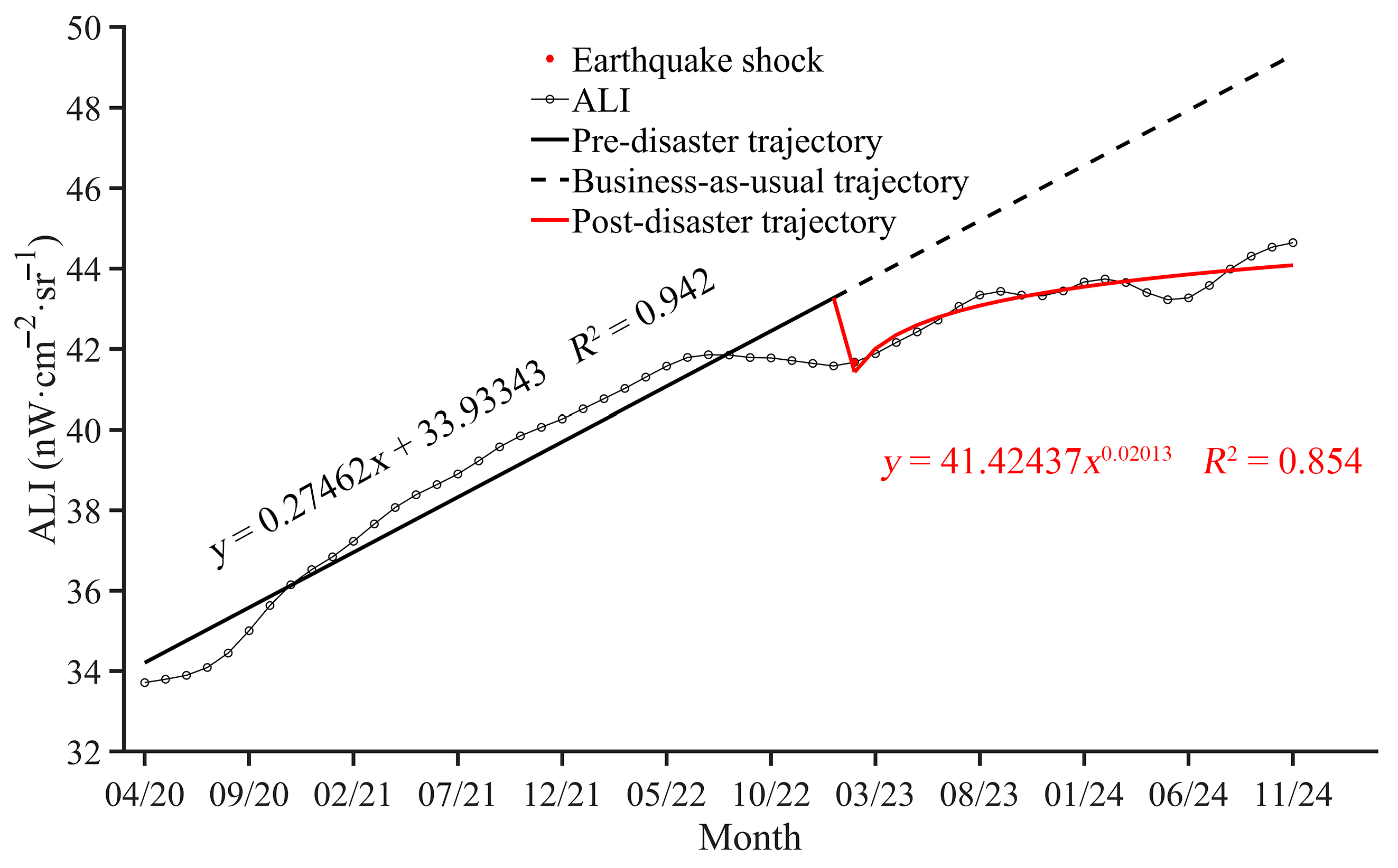
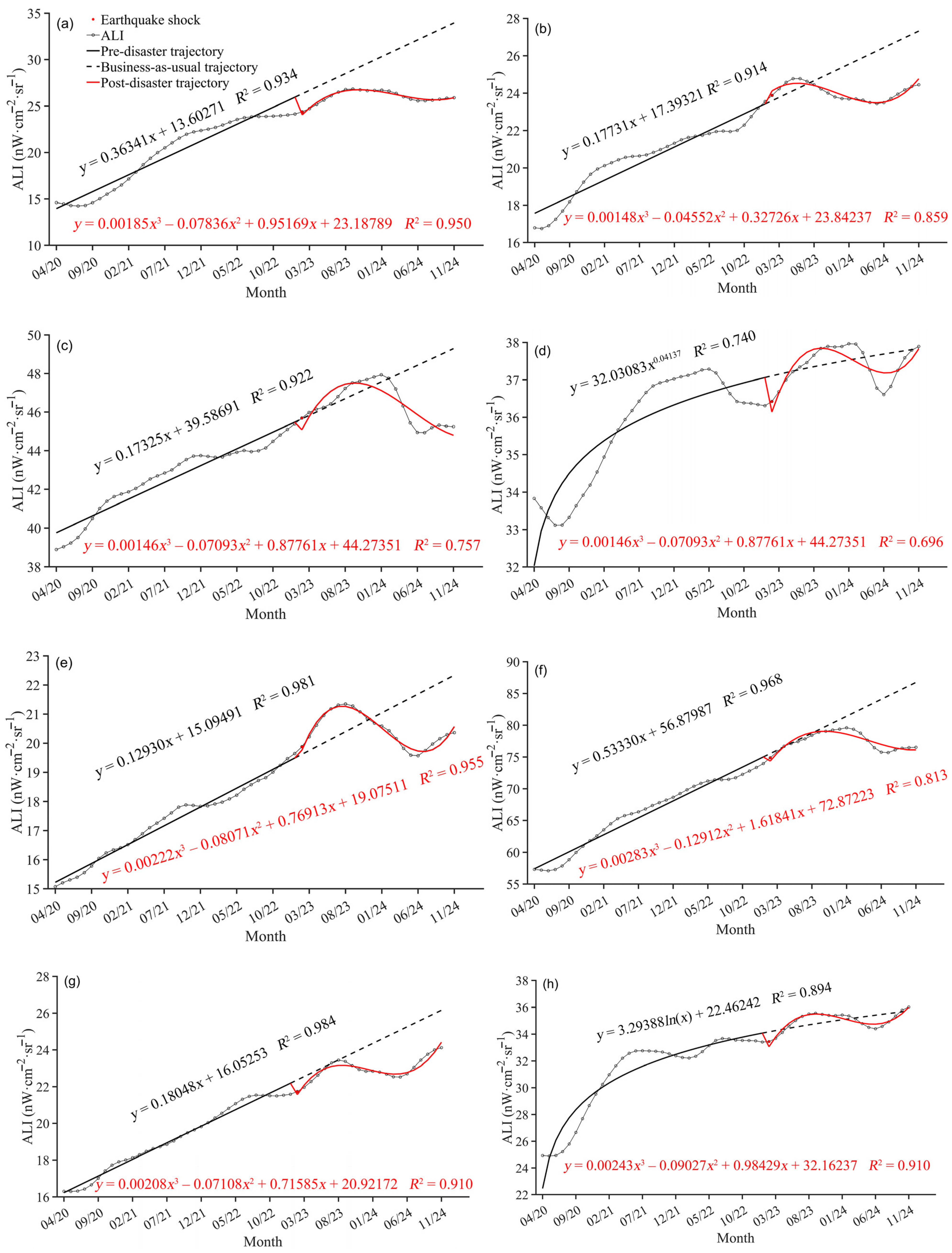
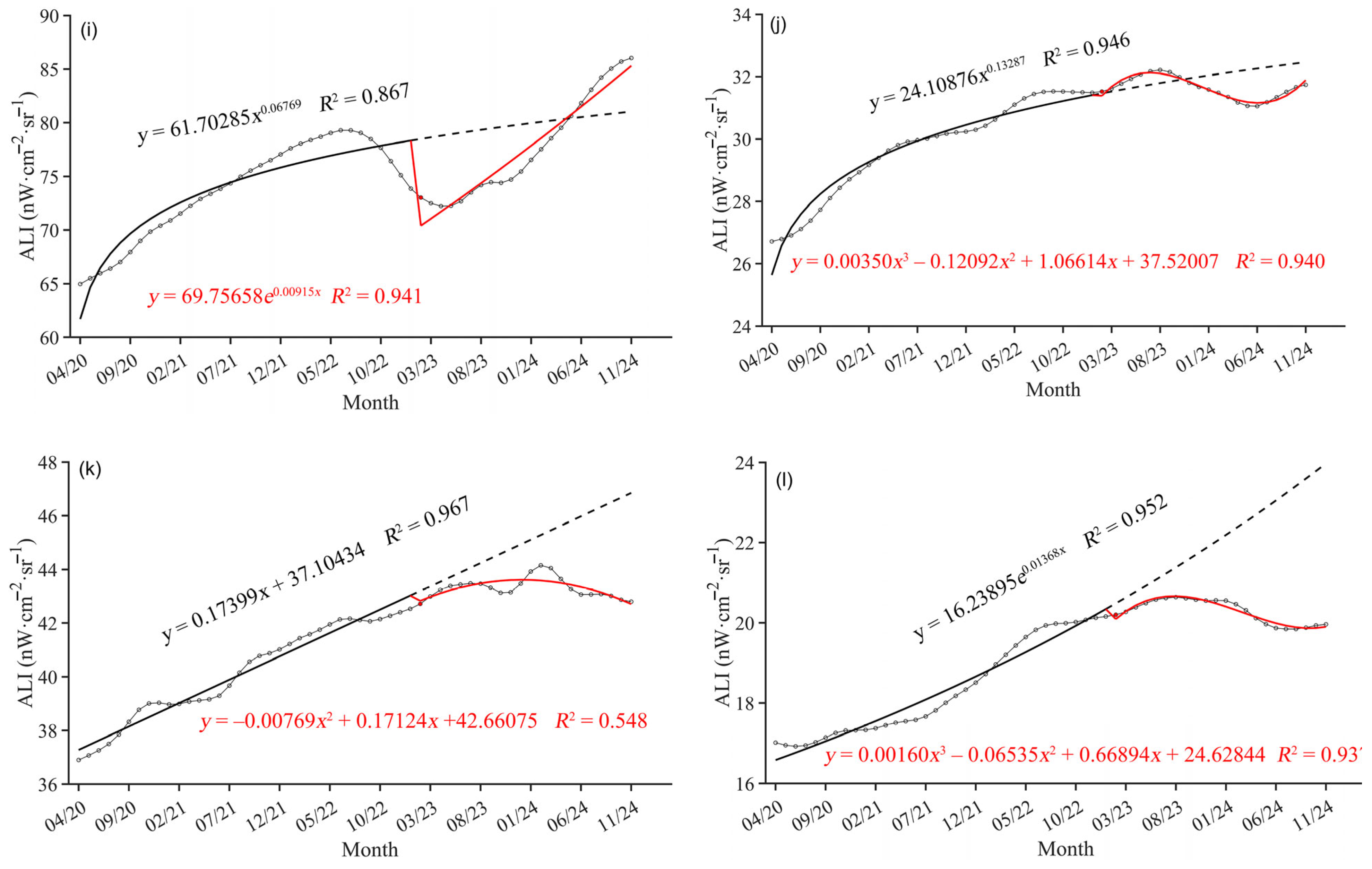
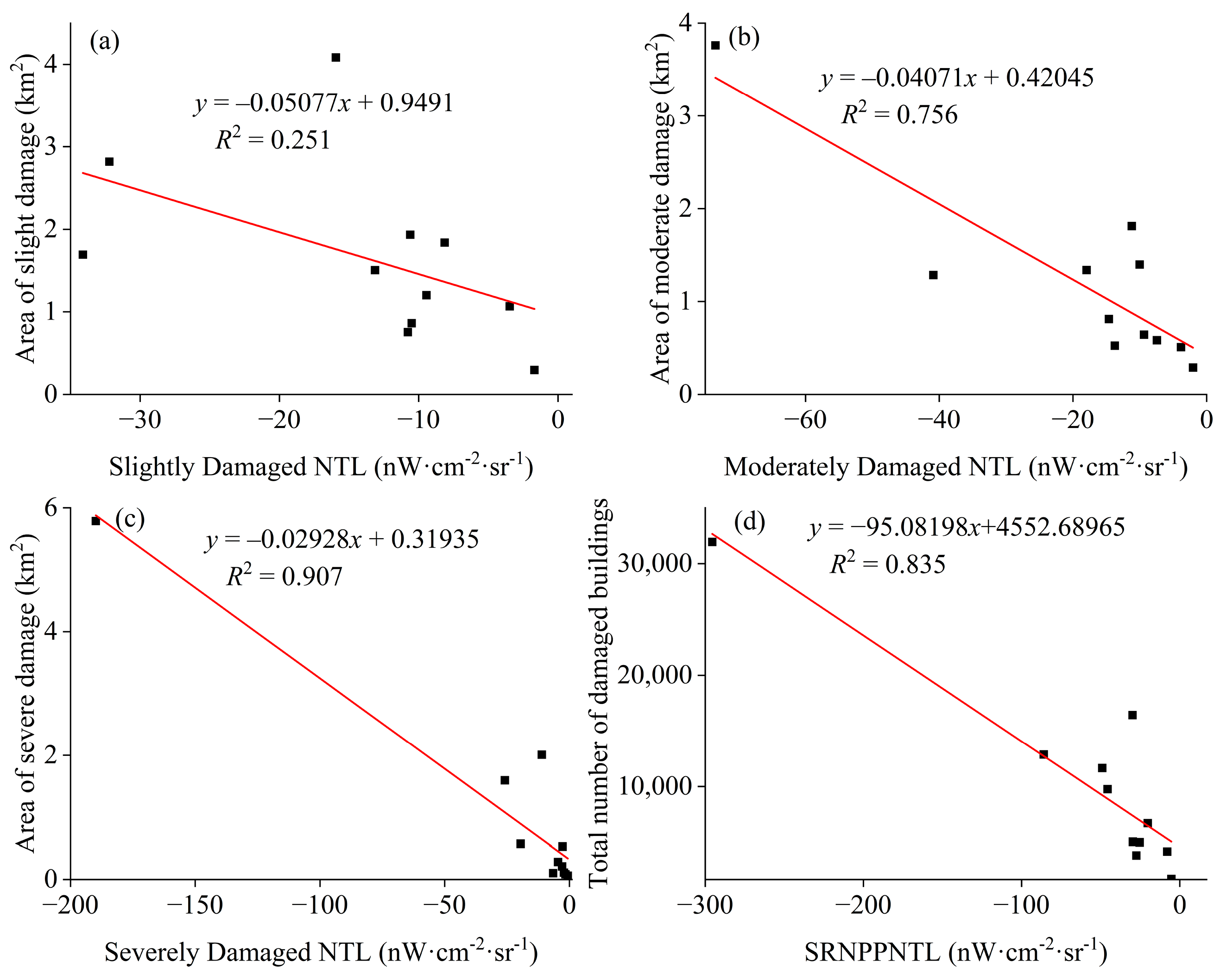
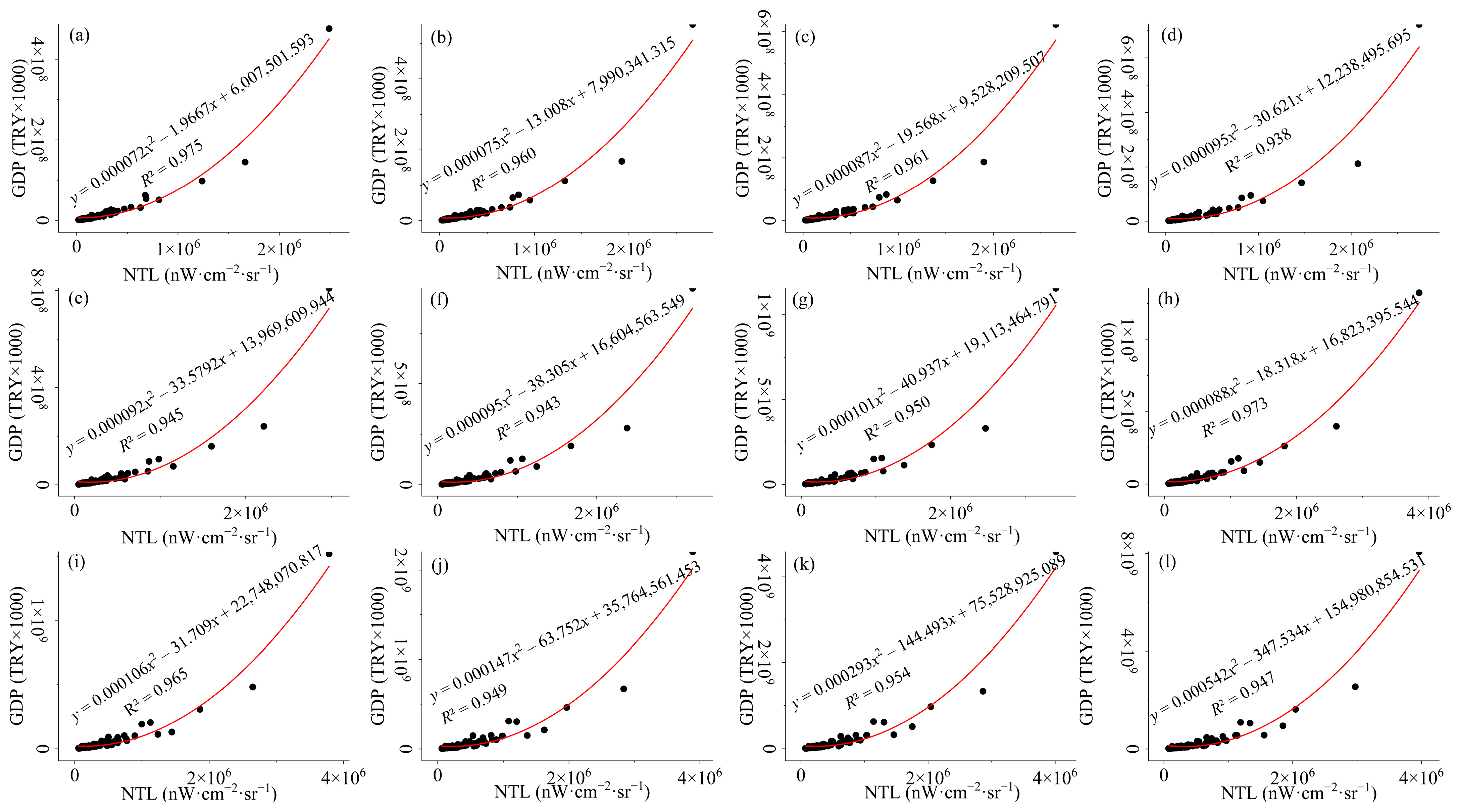
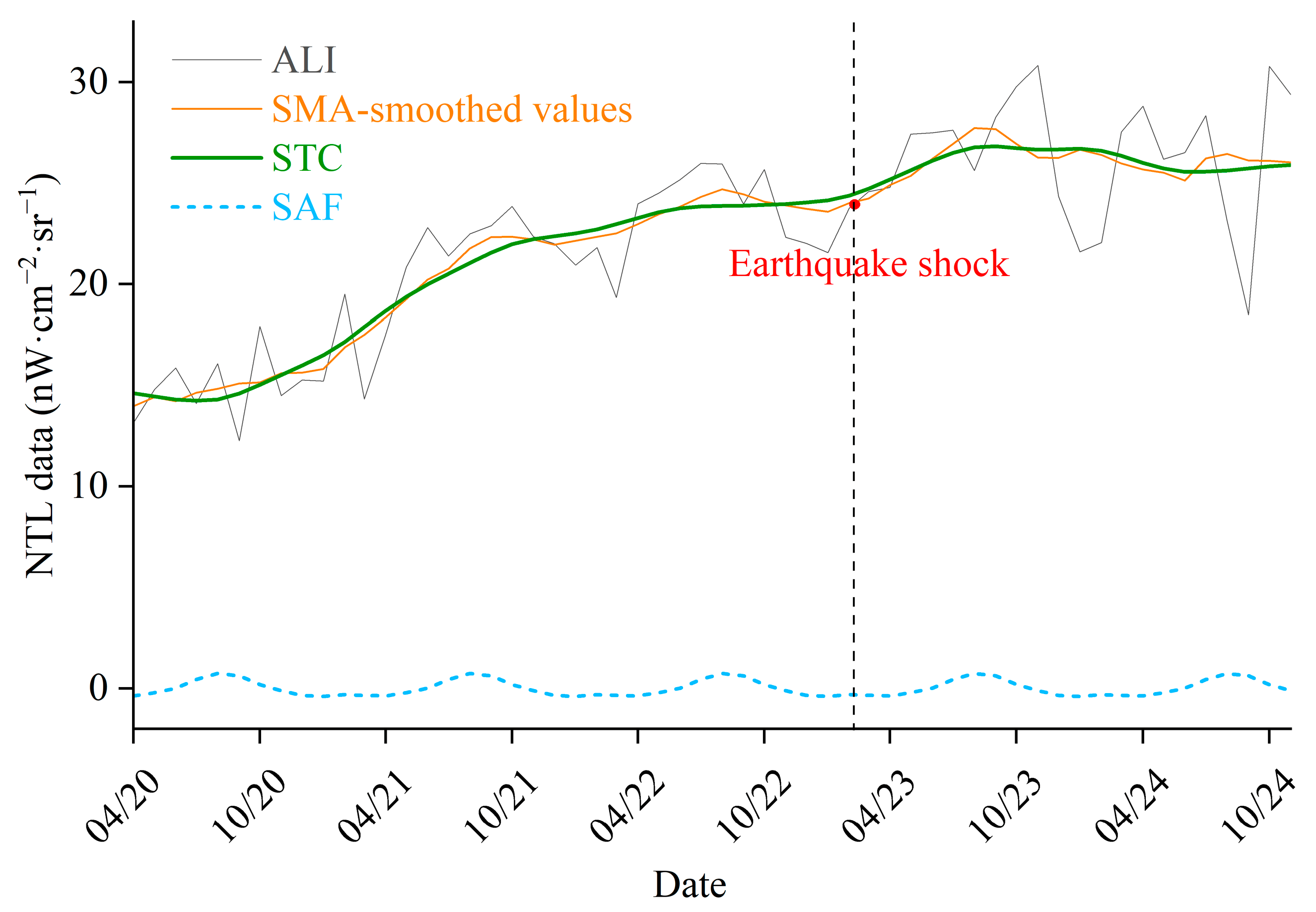
| Data Type | Data Description | Time Range | Source | Purpose |
|---|---|---|---|---|
| NPP-VIIRS VNP46A1 DNB NTLs | Post-earthquake daily NTLs under less cloudy conditions | 12 February 2023 | LAADS DAAC | Assessment of potential damage from the earthquake disaster |
| NPP-VIIRS VNP46A3 monthly NTLs | Pre-earthquake monthly NTLs | January 2023 | LAADS DAAC | Assessment of potential damage from the earthquake disaster |
| Time series monthly NTLs | April 2020–November 2024 | LAADS DAAC | Assessment of the post-earthquake economic recovery | |
| Landsat 8 OLI image | Post-earthquake multispectral image | 16 July 2023 | EarthExplorer | Extraction of vegetation extent |
| Earthquake damage reference data | Reference map of building damage | Last updated on 9 May 2023 | EOS | Validation of NTL-identified building damage |
| Reference map of earthquake-damaged buildings | February 2023 | Earth Engine Apps | Validation of NTL-identified building damage | |
| Field photographs of structural damage | 3 April 2023 | EERI | Validation of NTL-identified building damage | |
| Provincial GDP statistics | Provincial GDP statistics in Turkey | 2012–2023 | TURKSTAT | Analysis of the regression relationship between NTLs and economic activity in Turkey |
| Administrative divisions | Administrative boundaries for 12 districts in Hatay Province, Turkey | 2022 | GADM | Assessment of the post-earthquake economic recovery across the districts |
| Reference Source | Category | CE | OE | OA | KC |
|---|---|---|---|---|---|
| EOS | Damage | 26.66% | 18.43% | 77.28% | 0.55 |
| No damage | 18.35% | 26.56% | |||
| Earth Engine Apps | Damage | 29.30% | 25.88% | 71.55% | 0.43 |
| No damage | 27.49% | 31.04% |
| District | Pre-Earthquake | District | Post-Earthquake | ||||
|---|---|---|---|---|---|---|---|
| R2 | F | p | R2 | F | p | ||
| Hatay | 0.94 | 522.86 | 0.00 | Hatay | 0.85 | 117.34 | 0.00 |
| Altinozu | 0.93 | 455.05 | 0.00 | Altinozu | 0.95 | 114.41 | 0.00 |
| Belen | 0.91 | 341.40 | 0.00 | Belen | 0.86 | 36.56 | 0.00 |
| Dortyol | 0.92 | 375.68 | 0.00 | Dortyol | 0.76 | 18.73 | 0.00 |
| Erzin | 0.74 | 91.19 | 0.00 | Erzin | 0.70 | 13.72 | 0.00 |
| Hassa | 0.98 | 1633.23 | 0.00 | Hassa | 0.96 | 128.72 | 0.00 |
| Iskenderun | 0.97 | 957.90 | 0.00 | Iskenderun | 0.81 | 26.17 | 0.00 |
| Kirikhan | 0.98 | 1923.83 | 0.00 | Kirikhan | 0.91 | 60.62 | 0.00 |
| Kumlu | 0.89 | 271.01 | 0.00 | Kumlu | 0.91 | 60.38 | 0.00 |
| Antakya | 0.87 | 209.03 | 0.00 | Antakya | 0.94 | 318.92 | 0.00 |
| Reyhanli | 0.95 | 559.58 | 0.00 | Reyhanli | 0.94 | 94.06 | 0.00 |
| Samandag | 0.97 | 930.72 | 0.00 | Samandag | 0.55 | 11.50 | 0.00 |
| Yayladagi | 0.95 | 631.81 | 0.00 | Yayladagi | 0.94 | 89.17 | 0.00 |
Disclaimer/Publisher’s Note: The statements, opinions and data contained in all publications are solely those of the individual author(s) and contributor(s) and not of MDPI and/or the editor(s). MDPI and/or the editor(s) disclaim responsibility for any injury to people or property resulting from any ideas, methods, instructions or products referred to in the content. |
© 2025 by the authors. Published by MDPI on behalf of the International Society for Photogrammetry and Remote Sensing. Licensee MDPI, Basel, Switzerland. This article is an open access article distributed under the terms and conditions of the Creative Commons Attribution (CC BY) license (https://creativecommons.org/licenses/by/4.0/).
Share and Cite
Li, F.; Liao, S.; Fu, X.; Liu, T. NPP-VIIRS Nighttime Lights Illustrate the Post-Earthquake Damage and Subsequent Economic Recovery in Hatay Province, Turkey. ISPRS Int. J. Geo-Inf. 2025, 14, 149. https://doi.org/10.3390/ijgi14040149
Li F, Liao S, Fu X, Liu T. NPP-VIIRS Nighttime Lights Illustrate the Post-Earthquake Damage and Subsequent Economic Recovery in Hatay Province, Turkey. ISPRS International Journal of Geo-Information. 2025; 14(4):149. https://doi.org/10.3390/ijgi14040149
Chicago/Turabian StyleLi, Feng, Shunbao Liao, Xingjian Fu, and Tianxuan Liu. 2025. "NPP-VIIRS Nighttime Lights Illustrate the Post-Earthquake Damage and Subsequent Economic Recovery in Hatay Province, Turkey" ISPRS International Journal of Geo-Information 14, no. 4: 149. https://doi.org/10.3390/ijgi14040149
APA StyleLi, F., Liao, S., Fu, X., & Liu, T. (2025). NPP-VIIRS Nighttime Lights Illustrate the Post-Earthquake Damage and Subsequent Economic Recovery in Hatay Province, Turkey. ISPRS International Journal of Geo-Information, 14(4), 149. https://doi.org/10.3390/ijgi14040149








